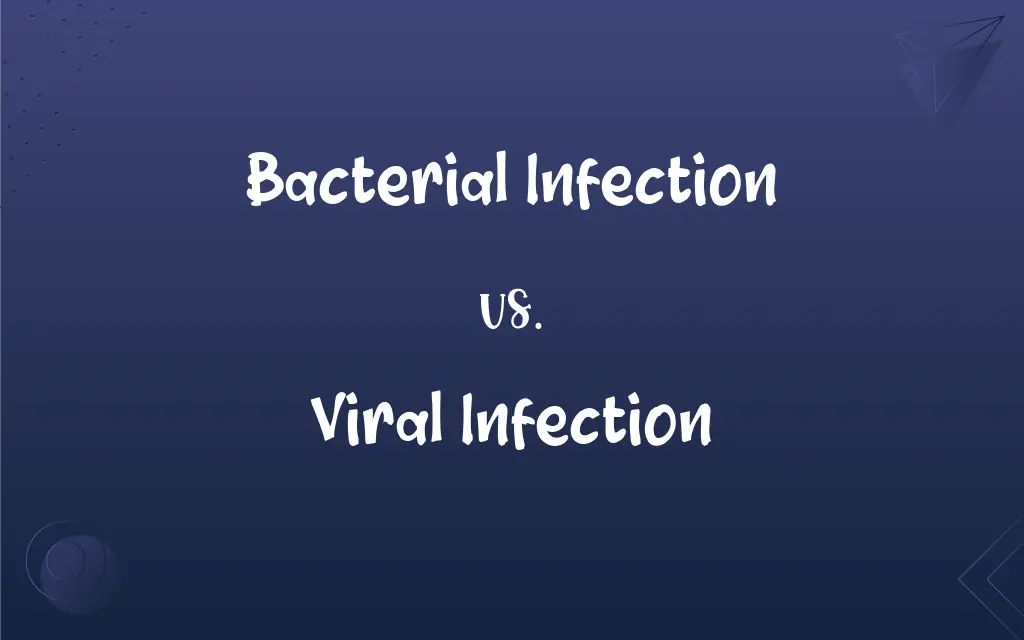Bacterial Infection vs. Viral Infection: What's the Difference?
Edited by Aimie Carlson || By Harlon Moss || Updated on October 9, 2023
Bacterial infection is caused by harmful bacteria, while a viral infection is caused by viruses, each having distinct treatment approaches.

Key Differences
Bacterial Infections and Viral Infections differentiate primarily in their causal organisms: bacteria and viruses, respectively. Bacterial infections involve harmful bacteria invading the host organism and causing illness. On the other hand, viral infections pertain to diseases emerging from invasive viruses attacking and using host cells for replication.
Bacterial Infections can often be treated effectively with antibiotics, aiming to kill the harmful bacteria or inhibit their growth. However, antibiotics have no impact on Viral Infections, which cannot be cured by antibiotics, since viruses have a different structural and reproductive nature, requiring antiviral medications or vaccines for prevention and management.
When observing Bacterial Infections, the symptoms may be localized, affecting one area of the body, while Viral Infections often present systemic symptoms, influencing multiple parts or systems within the host. Additionally, bacterial infections might present with purulent discharge, which is generally less common in viral infections.
Generally, Bacterial Infections may persist until effectively treated with appropriate medications, whereas many Viral Infections may resolve on their own, with the immune system playing a pivotal role in managing and overcoming the invasive entities. Vaccines are often more prevalently utilized in preventing viral infections due to their self-limiting nature.
Comparison Chart
Causal Organism
Bacteria
Viruses
ADVERTISEMENT
Treatment
Typically antibiotics
Typically antiviral medications
Symptom Location
Often localized
Often systemic
Use of Vaccines
Less common
More common
Duration
Until treated, can be prolonged
Often self-limiting
Bacterial Infection and Viral Infection Definitions
Bacterial Infection
Bacterial infections can vary widely in severity, from mild and easily treatable conditions to severe or life-threatening illnesses.
Though the bacterial infection started as a minor inconvenience, it quickly escalated, requiring hospitalization.
ADVERTISEMENT
Viral Infection
A viral infection occurs when an organism's body is invaded by disease-causing viruses.
After traveling, she fell ill with a viral infection that caused fever and fatigue.
Bacterial Infection
Certain bacterial infections may pose risks of spreading from the affected individual to others, depending on the bacteria type and infection site.
The school experienced an outbreak of a contagious bacterial infection, prompting a temporary closure.
Viral Infection
Vaccines are a key tool in preventing various viral infections by training the immune system to recognize and fight the virus.
The development of a vaccine for a specific viral infection significantly reduces related morbidity and mortality rates.
Bacterial Infection
Bacterial infections may exhibit symptoms localized to a specific area of the body where the bacteria are proliferating.
The bacterial infection in his throat caused persistent pain and swelling.
Viral Infection
Viral infections usually involve systemic illness, affecting multiple parts of the body simultaneously.
The viral infection manifested with a myriad of symptoms like headache, fever, and body aches all at once.
Bacterial Infection
A bacterial infection can typically be addressed and potentially cured using appropriate antibiotics.
The physician prescribed a course of antibiotics to manage her bacterial infection.
Viral Infection
Viral infections cannot be treated with antibiotics and often must run their course.
He was advised to rest and stay hydrated while the viral infection worked its way through his system.
Bacterial Infection
A bacterial infection denotes a condition where harmful bacteria invade and multiply within the host.
The wound developed a bacterial infection, which was subsequently treated with antibiotics.
Viral Infection
Many viral infections, such as the flu, are highly contagious and can be spread from person to person.
School closures sometimes occur to prevent the spread of a widespread viral infection among students and staff.
FAQs
Are bacterial infections contagious?
Some bacterial infections can be contagious and spread between individuals.
Can bacterial infections be prevented with vaccines?
Yes, certain bacterial infections can be prevented with vaccines, e.g., Tuberculosis.
Can bacterial infections resolve without treatment?
Some might, but others require medical intervention for resolution.
Can you treat a viral infection with antibiotics?
No, antibiotics are not effective against viruses.
What causes a bacterial infection?
Bacterial infections are caused by the invasion and multiplication of harmful bacteria in the host body.
How are bacterial infections treated?
They are typically treated with antibiotics.
How are viral infections usually treated?
Viral infections often require supportive care, while some can be treated with antiviral medications.
Do viral infections always cause disease?
No, some viral infections can be asymptomatic.
What initiates a viral infection?
Viral infections begin when viruses invade cells in the host’s body and replicate.
Are vaccines available for viral infections?
Yes, numerous vaccines are available to prevent various viral infections, e.g., Influenza.
How does one differentiate between bacterial and viral infections?
Often through symptoms, medical history, and sometimes, laboratory tests.
Are all viral infections contagious?
Many viral infections are contagious, though the degree and method of transmission can vary.
How does the transmission of bacterial infections occur?
Bacterial infections can be transmitted through direct contact, ingestion, or via vectors like ticks.
Can bacterial infections reoccur?
Yes, bacterial infections can reoccur, even after treatment in some cases.
How long do viral infections last?
The duration of viral infections can vary, with some being brief and others prolonged.
Can bacterial and viral infections coexist?
Yes, it is possible to have both bacterial and viral infections simultaneously.
Can viral infections lead to bacterial infections?
Yes, viral infections can sometimes pave the way for bacterial infections.
What is antibiotic resistance in bacterial infections?
Antibiotic resistance occurs when bacteria evolve and are no longer affected by the antibiotics that once killed them.
Are viral infections more dangerous than bacterial infections?
Both can range from mild to severe; the danger level can depend on the specific pathogen, host factors, and circumstances.
How does immunity work against viral infections?
The immune system responds to a viral infection by recognizing, attacking the virus, and often developing a memory for future encounters.
About Author
Written by
Harlon MossHarlon is a seasoned quality moderator and accomplished content writer for Difference Wiki. An alumnus of the prestigious University of California, he earned his degree in Computer Science. Leveraging his academic background, Harlon brings a meticulous and informed perspective to his work, ensuring content accuracy and excellence.
Edited by
Aimie CarlsonAimie Carlson, holding a master's degree in English literature, is a fervent English language enthusiast. She lends her writing talents to Difference Wiki, a prominent website that specializes in comparisons, offering readers insightful analyses that both captivate and inform.






























































